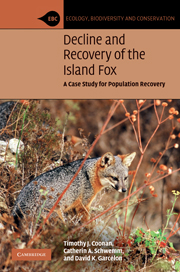Book contents
- Frontmatter
- Contents
- Foreword
- Acknowledgments
- 1 Introduction
- 2 Evolution and genetics
- 3 Social structure, reproduction, mortality and survivorship, and population dynamics
- 4 Food habits, habitat use, activity patterns, and dispersal
- 5 Golden eagles and the decline on the northern islands
- 6 Ecosystem recovery
- 7 Disease and decline on Santa Catalina Island
- 8 Recovery actions
- 9 Recovery actions
- 10 Reproductive biology, by Cheryl Asa
- 11 Diseases of island foxes, by Linda Munson
- 12 Zoos, education, and public participation
- 13 Managing recovery
- 14 The ecological role of island foxes
- 15 Conclusion
- References
- Index
15 - Conclusion
Published online by Cambridge University Press: 05 October 2010
- Frontmatter
- Contents
- Foreword
- Acknowledgments
- 1 Introduction
- 2 Evolution and genetics
- 3 Social structure, reproduction, mortality and survivorship, and population dynamics
- 4 Food habits, habitat use, activity patterns, and dispersal
- 5 Golden eagles and the decline on the northern islands
- 6 Ecosystem recovery
- 7 Disease and decline on Santa Catalina Island
- 8 Recovery actions
- 9 Recovery actions
- 10 Reproductive biology, by Cheryl Asa
- 11 Diseases of island foxes, by Linda Munson
- 12 Zoos, education, and public participation
- 13 Managing recovery
- 14 The ecological role of island foxes
- 15 Conclusion
- References
- Index
Summary
Status
By 2008 all four of the captive breeding programs for island foxes had ended, and by 2009 each of the six island fox subspecies, including the four listed as endangered in 2004, were either stable or increasing. Both major mortality factors that had driven the declines of the 1990s – golden eagle predation and canine distemper virus (CDV) – had been successfully mitigated. Population monitoring in 2009 showed that the estimated population of foxes on San Miguel was over 320, while on Santa Rosa there were close to 400 foxes (NPS unpublished data). On Santa Cruz and Santa Catalina populations had grown even more rapidly, with a 2008 adult population estimate of 740 on Santa Cruz (V. Bakker, Arizona State University, unpublished data), and over 700 on Santa Catalina (J. King, Catalina Island Conservancy, unpublished data). The two non-listed subspecies on San Nicolas and San Clemente had stable populations of at least 500 adults.
The existence of stable or upward trends for all subspecies in 2009 is testament to the effectiveness of the major recovery actions implemented during the previous decade. From 1999 to 2006, the relocation of 44 golden eagles from the northern islands coincided with an increase in fox survival. As of 2009 there were occasional visits to the islands by transient golden eagles that preyed on foxes, but golden eagles no longer bred on the islands, and recent predation can be viewed more as isolated incidents rather than having an impact on fox populations, all of which had annual survival of 80–95% in 2008 and 2009.
- Type
- Chapter
- Information
- Decline and Recovery of the Island FoxA Case Study for Population Recovery, pp. 180 - 184Publisher: Cambridge University PressPrint publication year: 2010



